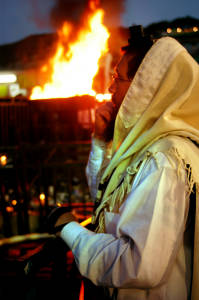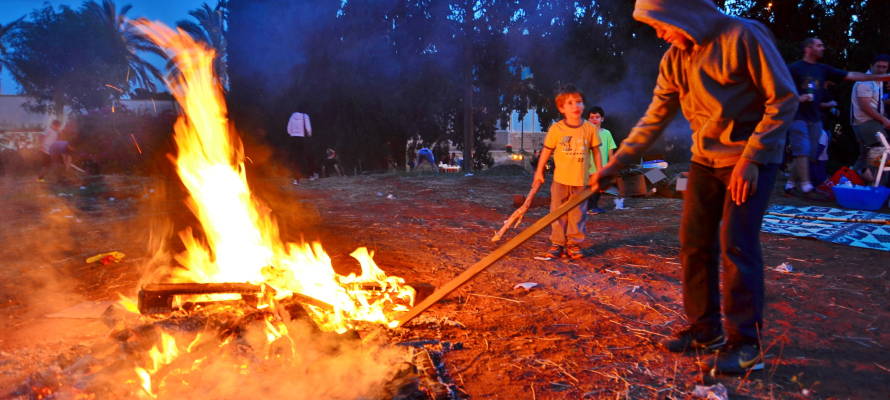There are several fascinating explanations regarding the meaning of the unique holiday of Lag B’Omer and why ‘holy fires’ play such a prominent role.
By Rabbi Ari Enkin, Rabbinic Director, United with Israel
Lag B’omer marks the cessation of the plague that killed 24,000 students of beloved scholar Rabbi Akiva (50-135 AD). It might just be that this plague was the failed Bar Kochba revolt in which Rabbi Akiva’s students were killed by the Romans.
Lag B’omer also marks the yartzeit (anniversary of date of death) of the great Rabbi Shimon Bar Yochai, who, among his many accomplishments, allegedly authored the Zohar, the primary work on Kabbalah.
It is noted as well that Lag B’omer is the day when the Manna began to fall from Heaven to sustain the Jewish people in the desert.
Bonfires and Singing Occur Throughout Israel
A prominent feature of the celebrations is the bonfires, and in Israel groups of people singing around a bonfire can be seen across the country. There is much discussion on what these bonfires represent. Some suggest that it is to recall the fire which was said to have erupted at the moment of Rabbi Shimon Bar Yochai’s death.
It is also intended to recall Rabbi Shimon Bar Yochai’s gaze, which was said to be as powerful as fire and would vaporize anything that earned his disfavor. Finally, bonfires represent the “fire” of Torah, especially the esoteric side that Rabbi Shimon Bar Yochai revealed through the Zohar and other mystical teachings.

Lag b’Omer in Meron (shutterstock)
Although one might think that a day of fasting and introspection would be appropriate for the yartzeit (anniversary of the death) of a tzaddik, a righteous person, as is the case regarding Moses, but Lag B’omer is uniquely different. Rabbi Shimon Bar Yochai had requested that the day of his death become an annual celebration, as it is the day on which he would reveal many secrets of the Torah.
It is also said to be the day Rabbi Shimon Bar Yochai received smicha (rabbinic ordination) from Rabbi Akiva. Many also consider celebration of Lag B’omer appropriate because Rabbi Shimon Bar Yochai was miraculously saved that day from the Roman government, which had sentenced him to death for the spreading of Torah.
Those in Israel who are able to ascend to the tomb of Rabbi Shimon Bar Yochai, located in the northern city of Meron, are encouraged to do so and to organize a meal in honor of Rabbi Shimon Bar Yochai.
In 2024, due to incessant rocket attacks from Hezbollah in the north, Meron has been closed as military zone.
Rabbi Ovadia Bartenura, renowned 15th-century spiritual leader, wrote: “On the 18th day of Iyar, the day of the yartzeit of Rabbi Shimon Bar Yochai, people from surrounding areas gather and light huge bonfires in addition to lighting candles. Many barren women have been helped and many sick have been healed.”
The average attendance in Meron on Lag B’omer numbers 200,000! Those unable to travel there should at least study the teachings of Rabbi Shimon Bar Yochai throughout the day.
Why Do Children Play with Bows and Arrows?
There is a well-known Lag B’omer custom for children to play with bows and arrows, which is said to be alluded to in the verse: “And the sons of Ulam were mighty men of valor, shooters of bows (archers), and had many sons, and sons’ sons.” (1 Chronicles 8:40)
Based on this verse, the famed Rabbi Nachman of Breslov teaches that playing with bows and arrows is a segula (hopeful omen) for having children.
It is explained that playing with bows and arrows on Lag B’omer recalls that during the lifetime of Rabbi Shimon bar Yochai, no rainbow had been seen. This is because the rainbow, which represents God’s protection over the world, would have been superfluous, as Rabbi Shimon bar Yochai served this purpose.
So too, the Hebrew word for bow, keshet, is the same gematria (numerical equivalence of the letters) as Rabbi Shimon Bar Yochai.
Another reason offered for the custom is to recall the Roman decree that prohibited all Torah study. Rabbi Shimon bar Yochai and his students would trek to the forests, equipped with bows and arrows, in order to study Torah. When confronted by Roman policemen, they would claim that they were on a hunting trip.
Similarly, the military nature of bows and arrows is intended to recall the revolt against the Romans in 135 C.E., led by Rabbi Akiva, who was the primary teacher of Rabbi Shimon bar Yochai.
The Lubavitcher Rebbe explains that the bows and arrows represent a person’s diligence and success in Torah study. The archer knows that the further he desires his arrow to reach, the more he must draw the string inward towards himself. The more he bends it, the further and faster the arrow will fly.
So it is with Torah study. The more time and effort one invests in Torah study, the more one will succeed. The Rebbe also notes that the archer positions the bow and arrow close to his heart. Likewise, one must ensure that Torah study always remains close to one’s heart.
Do You Love Israel? Make a Donation - Show Your Support!
Donate to vital charities that help protect Israeli citizens and inspire millions around the world to support Israel too!
Now more than ever, Israel needs your help to fight and win the war -- including on the battlefield of public opinion.
Antisemitism, anti-Israel bias and boycotts are out of control. Israel's enemies are inciting terror and violence against innocent Israelis and Jews around the world. Help us fight back!



